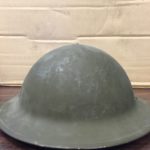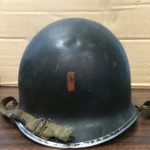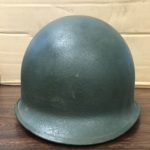Last Wednesday, a woman came into OHA and donated four army helmets from World War I and World War II.
(Photos: 1 – U.S WWI, 2 – WWII 1st Division, 3 – WWII (unknown division)
- U.S WWI
- U.S WWII 1st Division
- U.S WWII (unkown division)
After taking some photos and researching them a bit more, we happened to see recently accessioned World War II Ration Books. These books were an important part of the war effort, as supplies were sent to Europe during and after the war.
The United States’ rationing program during World War II affected millions of people from 1943 until the war’s end in 1946 – about 130,000,000 people.[1] Created in April of 1941, the Office of Price Administration and Civilian Supply (later named the Office of Price Administration or OPA) was established to help quell the wartime inflation that Americans experienced during World War I due to the shipping of goods overseas.[2] In January 1942, with the passing of the Emergency Price Control Act, the OPA was given more authority over pricing, setting price ceilings on commodities.[3] Further, under the Second War Powers Act of 1942, products were given priority to the armed services,America’s allies, and finally to American civilians.[4]
There were five methods for rationing developed by the OPA, which included stamps, coupons, tokens (photo #3), certificates, and checks.[5] War Ration books were instituted and made available through an application to American families from May 1942 to the end of 1945 each containing a months worth of stamps. Stamps would only be redeemable for a specific amount of time to avoid hoarding, which newspapers would report daily.[6] Ration Book One
was distributed May 4th through May 7th of 1942 containing twenty-eight stamps and was a part of Uniform Coupon
Rationing.[7] This system offered equal amounts of a single commodity, in this case used for the purchase of sugar.[9] Upon retrieval of their book, applicants signed a form stating the amount of sugar previously purchased. Any amount over two pounds of sugar per person was measured and an equivalent amount of stamps were removed from the booklet.[10] Purchases of sugar were limited to one-half pound per week. The OPA eventually changed what these stamps could be used for during the course of the war, ultimately being used for the purchase of coffee and shoes.[11]
During this time, the OPA also implemented a point system, with more points placed on items that were scarce and that could be used for a combination of items.[12] First introduced in Ration Book One, the
system slightly changed starting in January of 1943 with the introduction of War Ration Book Two (see figure 7 & 8). In the second book, stamps came in two colors, red and blue, and continued to use the point system.[13] Red stamps gave the owner of the book the ability to buy butter, oils, meat, and with some exceptions cheese.[14] Blue stamps allowed for the purchase of frozen, canned and bottled fruits, juices, vegetables, along with processed foods such as soups and baby food.[15] Each book came with four pages of blue stamps and four pages of red stamps.[16] As with the sugar, people who had what was considered an excess amount of these goods had stamps removed from their ration book, though goods that people canned themselves did not have to be reported.[17]
Ration Book Three (photo #1 above) was issued in September and October of 1943 followed by Ration Book Four (photo #2 above ) in late 1943, both of which were used through 1945.[18] Ration Book Three came with brown stamps, which replaced red ones on September 12th, 1943.[19] These stamps were used for butter, cheese, lards, and other fats.[20] Ration Book Four, printed in red, blue, and green, was used in along with blue and red cardboard tokens, which were used as change for retailers.[21]
Sources
[1] Kitty Pittman, “Rationing in World War II: An Introduction into a Collection,” Oklahoma Department of Libraries, 2013, http://www.odl.state.ok.us/oar/resources/rationing/index.htm.
[2] Tally D. Fugate, “Rationing,” Oklahoma Historical Society, 2013, http://digital.library.okstate.edu/encyclopedia/entries/r/ra016.html.
[3] Ibid.
[4] Ibid.
[5] Fugate, “Rationing.”
[6] Ibid.
[7] Pittman, Kitty, “Rationing
[8] Alan Spohnheimer and Casie Vance, “World War II Rationing on the U.S. Home front,” Ames
Historical Society, 2013, http://www.ameshistory.org/exhibits/events/rationing.htm.
[9] Pittman, “Rationing in World War II.”
[10] Ibid.
[11] Fugate, “Rationing.”
[12] Fugate, “Rationing.”
[13] Spohnheimer and Vance, “World War II Rationing.”
[14] Fugate, “Rationing.”
[15] Ibid.
[16] Pittman, “Rationing”
[17] Fugate,“Rationing.”
[18] Spohnheimer and Vance, “World War II Rationing.”
[19] “Brown Ration Stamps Will Replace Red Ones Sept 12.” St. Petersburg Times. August 17th 1943, 8.
[20] Pittman, “Rationing”
[21] Angela Goebel Bain ed. and Dr. Barbara Mathews ed. “World War II Ration Book Four,”







